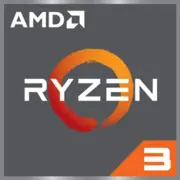AMD Ryzen 3 PRO 3200GE

AMD Ryzen 3 PRO 3200GE: Budget APU for Office and Multimedia in 2025
(Relevant as of April 2025)
Key Features: Zen+ in the Era of 5nm Technologies
The AMD Ryzen 3 PRO 3200GE processor, released in 2019, remains a popular choice for budget builds. Despite its age, its Zen+ architecture and 12nm process technology provide sufficient performance for basic tasks.
- Cores and Threads: 4 cores / 4 threads. Base clock speed is 3.3 GHz, with dynamic boost up to 3.8 GHz.
- Cache: 4MB L3 — modest for 2025, but sufficient for office applications.
- TDP 35W: One of the key benefits is low power consumption. This makes it ideal for compact PCs and systems without active cooling.
- Integrated Graphics: Radeon Vega 8 (8 cores, 1200 MHz). In 2025, it struggles with modern games but is adequate for HD video and older projects.
- Performance: In Geekbench 6 — 1127 (single-core) and 3204 (multi-core). For comparison, the Ryzen 5 5500 (6 cores, 2022) scores ~1500/6000.
Key Features:
- Support for AMD PRO technologies (security and remote management).
- Energy efficiency — suitable for "quiet" builds.
Compatible Motherboards: AM4 Still Lives
The Ryzen 3 PRO 3200GE uses the AM4 socket, allowing for a wide selection of motherboards from models made between 2017 and 2022.
Recommended Chipsets:
- A320: Budget option (e.g., ASUS Prime A320M-K, $50–$60). Suitable for office tasks but does not support overclocking.
- B450: Optimal choice (MSI B450 Tomahawk Max, $80–$100). Features PCIe 3.0, NVMe support, and memory overclocking.
- X470: For enthusiasts (Gigabyte X470 AORUS Ultra Gaming, $120–$150). Overkill for the 3200GE but relevant for upgrades.
Important:
- Update BIOS before installing the processor. Older motherboards may require a transitional CPU (e.g., Athlon 200GE).
- Choose models with HDMI/DisplayPort to use Vega 8.
Memory: DDR4 – Limitation or Advantage?
The Ryzen 3 PRO 3200GE only supports DDR4 with speeds up to 2933 MHz (officially). In 2025, DDR5 dominates, but DDR4 is cheaper:
- 16GB DDR4-3200 (TeamGroup Vulcan Z) — $35–$40.
- For maximum Vega 8 performance, use dual-channel mode (2×8 GB instead of 1×16 GB).
Tip: Don’t chase high frequencies. The performance gain in games from 3200 MHz versus 2933 MHz will only be about 3–5%.
Power Supply: 400W is Ample with Headroom
With a TDP of 35W and no discrete graphics card, a system based on the 3200GE consumes no more than 100–120W under load.
Recommendations:
- Basic builds: EVGA 400W (80+ White, $40) or Be Quiet! System Power 10 (450W, $55).
- For future upgrades (e.g., adding a graphics card), choose a power supply between 500–600W (Corsair CX650M, $75).
Pros and Cons: Who is the 3200GE Relevant for in 2025?
Pros:
- Low price: $80–$100 for a new processor (as of April 2025).
- Energy efficiency — suitable for mini-PCs and HTPCs.
- Integrated Vega 8 graphics — no need for a discrete graphics card.
Cons:
- Only 4 threads — multitasking is limited (e.g., streaming + gaming = lagging).
- Outdated process technology — lags behind modern APUs in performance per watt.
Use Cases: Where is the 3200GE Still Relevant
1. Office Tasks:
- Document work, browsing (20+ tabs), Zoom conferences.
- Example: Setting up a PC for a call center — quiet operation and low power costs.
2. Multimedia:
- 4K video playback (with hardware decoding via VEGA 8).
- Mini-PC for TV (e.g., ASRock DeskMini).
3. Light Gaming:
- CS:GO — 50–60 FPS on medium settings (1080p).
- GTA V — 30–40 FPS (low settings).
Comparison with Competitors: Budget Battle
1. Intel Core i3-10100 (4/8, UHD 630):
- Pros: Hyper-Threading (8 threads).
- Cons: Weak graphics. Price: $90–$110.
- Conclusion: 3200GE outperforms in graphics-related tasks, while i3 excels in multi-threading.
2. Ryzen 5 3400G (4/8, Vega 11):
- Pros: Vega 11 is 15% faster.
- Cons: TDP 65W, price $120–$140.
- Conclusion: For gaming, the 3400G is better, but the 3200GE is more economical.
3. Intel N100 (modern equivalent):
- Pros: 7nm, TDP 6W.
- Cons: Only 4 E-core threads, lacks PCIe 4.0.
- Conclusion: N100 is for ultra-portable systems, while 3200GE is for desktops.
Assembly Tips: How to Avoid Mistakes
1. Motherboard: Choose B450 with HDMI 2.0 (e.g., Gigabyte B450M DS3H).
2. Memory: 16GB DDR4-3200 in dual channel is a must for gaming.
3. Storage: An NVMe SSD (Kingston NV2 500GB, $30) speeds up system boot time.
4. Cooling: The stock cooler is sufficient, but for quiet operation, consider a DeepCool GAMMAXX 400 ($20).
5. Case: Mini-ITX (Fractal Design Node 202) or Micro-ATX (Cooler Master Q300L).
Conclusion: Who is the Ryzen 3 PRO 3200GE Suitable for in 2025?
This processor is worth choosing if:
- You need a cheap PC for office or study.
- Energy efficiency is more important than maximum performance.
- Planning to build a media center or compact PC.
Do not choose the 3200GE if:
- You work with 3D rendering or video editing.
- You want to play modern games (better to add $50 and get the Ryzen 5 5600G).
Final Note: Despite its age, the Ryzen 3 PRO 3200GE remains a cost-effective option for niche tasks. Its main advantages are price and minimal system requirements. In 2025, it's a choice for those who value practicality over FPS records.
Basic
CPU Specifications
Memory Specifications
GPU Specifications
Miscellaneous
Benchmarks
Compared to Other CPU
Share in social media
Or Link To Us
<a href="https://cputronic.com/en/cpu/amd-ryzen-3-pro-3200ge" target="_blank">AMD Ryzen 3 PRO 3200GE</a>